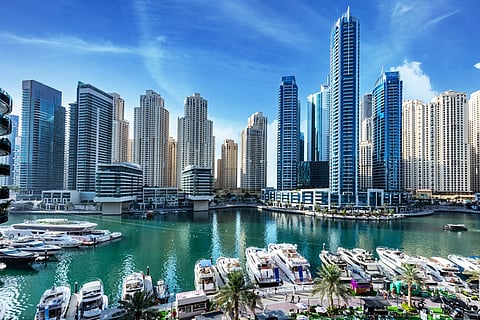
- Destinations
- Experiences
- Stay
- What's new
- Celebrating People
- Responsible Tourism
- CampaignsCampaigns
- SubscribeSubscribe
- Buy Now

Dubai plans to launch its first fleet of flying taxis in 2026, offering a new form of electric air travel designed to reduce travel times across the city. The service, developed by California-based Joby Aviation, will operate using electric vertical take-off and landing (eVTOL) aircraft.
Infrastructure for the flying taxis is currently in development, with regulatory approvals and safety measures also under review.
An initial route will connect Dubai International Airport with Palm Jumeirah, cutting the trip from around 45 minutes by car to approximately 12 minutes by air. The aircraft are expected to carry a small number of passengers and operate from dedicated landing areas known as vertiports.
Dubai’s planned air taxi network is expected to launch operations from four main vertiports currently under development, according to reports. The sites include Dubai International Airport (DXB), Downtown Dubai, Dubai Marina, and Palm Jumeirah—locations chosen for their proximity to high-traffic areas and tourist destinations.
The first vertiport at DXB is on track for completion by early 2026. The network is being designed to provide quick, point-to-point travel over congested parts of the city, reducing surface traffic and travel time between key hubs.
Passengers will be able to book flights through a mobile app, with functionality similar to existing ride-hailing platforms. Joby Aviation, the company behind the aircraft, is a global partner of Uber, and integration with the Uber app is expected to allow users to schedule, board, and pay for air taxi rides within a single platform. Over time, the service is expected to expand to include hotel rooftops and major landmarks, offering more direct access between the airport and popular destinations across the city.
Joby Aviation has indicated that the cost of a single air taxi trip in Dubai could be approximately USD 75, though final fares have not been confirmed. The estimated pricing would make the service comparable to high-end ride-hailing options currently available in the city.
Dubai is moving ahead with plans to launch its first fleet of electric air taxis by 2026, positioning the city as an early adopter of aerial urban mobility. Promising fast, on-demand travel across congested areas, the service is expected to reshape how residents and tourists move around the city. However, alongside the excitement, the project is also drawing attention for its potential environmental and social impacts. From noise pollution and energy sustainability to infrastructure development and equity concerns, the introduction of air taxis raises important questions about how new technologies affect urban life.
The air taxis are electric, but their environmental benefit depends on how clean the electricity supply is and the environmental impact of battery production and disposal. The production of batteries for electric air taxis requires mining of materials like lithium and other rare earth elements, which can have significant environmental consequences. The process can involve the use of chemicals that may contaminate water sources and ecosystems. Lithium extraction, particularly from brines, is a water-intensive process, consuming vast amounts of water resources in arid regions. Mining activities can lead to deforestation, soil erosion, and habitat destruction. The manufacturing and disposal of these batteries pose many environmental challenges.
